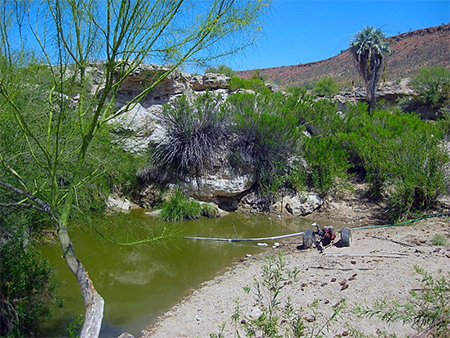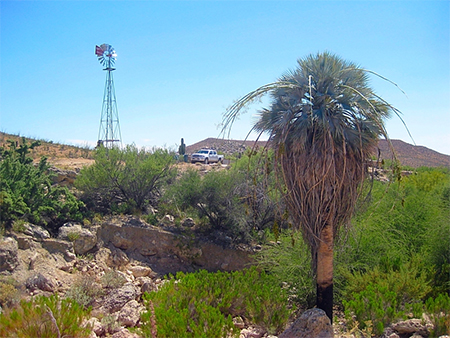 |  |
By David Kier

Agua Dulce is located 200 miles down the nearly 800-mile- long Baja California peninsula, about 12 miles north of Cataviña. GPS is 29° 52.980'N, 114° 49.420'W, with an elevation of 2,300 feet above sea level. I previously visited the spring in 2005 and was anxious to see what has changed in a dozen years.
The very first written mention of the spring comes from the diary of Jesuit Padre Wenceslaus Linck. On his expedition to find potential new mission sites, Linck and his party arrived at a spring the California Indians called Keita. This was on March 3, 1766 and on their return journey, on April 7, 1766. Padre Linck’s description matches that of the place we know now as Agua Dulce. The waterhole at Keita (Agua Dulce) was strategic for travel to the much finer and abundantly watered location at Velicatá. The Jesuits decided Velicatá would become a mission location.
On October 16, 1766, the next mission north of San Borja, was established. But, as Velicatá was deemed too far away in potential hostile territory, the Jesuits would first build at Calamajué. Linck stopped there on April 12, 1766. Linck was there during an especially wet month and unaware that the Calamajué year-round stream would poison crops once the dilution of rain water was gone. The Jesuits moved the new mission to Santa María after just seven months. Eight months after that, they were ordered expelled from all their missions by the Spanish government who distrusted the Jesuit’s activities.

Padre Junípero Serra and his troop of Franciscan missionaries arrived in April 1768 to revive the empty Jesuit missions in Baja California. A year later, the Franciscans were given new instructions from the Spanish government. They were ordered to extend their mission operations far north, at San Diego and Monterey. Serra traveled on a mule, using the Camino Real mission road system built by the Jesuits and across the new territory beyond. The Serra Party departed Loreto on March 28, 1769. They were preceded by Padre Juan Crespí and Captain Fernando de Rivera y Moncada who had begun the northern journey a month earlier. In Junípero Serra’s 1769 diary we find one of first uses of the name Agua Dulce (Sweet Water) for this spring:
“May 12. We arrived at the place called Pozo de Agua Dulce. Along the way we saw some small rancherías of gentiles and fresh footprints, but nobody, young or old, allowed themselves to be seen by us. Their reticence thwarted the hopes I had of seeing them, of speaking to them, and of cherishing them”.
In 1843, a young American named James Bull, traveled from Mulegé to San Diego and kept a diary of the day’s events. He wrote about arriving at Agua Dulce late in the afternoon. His companion told a story that not long before, a mountain lion was perched on the cliff above the spring and scared his mule so badly that not once was spurring required to reach Mission Santa María that same day!
Arthur North, riding through Baja California on the mission road in February 1906, arrived from the west. North and his party were following traces of El Camino Real from Mission San Fernando and San Agustin. There, slabs of beautiful onyx were stacked by a deserted cabin. The young mining operation was at a pause awaiting the workers return. Past San Agustin, North made camp at Agua Dulce by the large pool of fresh water.
In the 1956 Lower California Guidebook by Howard Gulick and Peter Gerhard, Agua Dulce is described: a natural reservoir in the rocks filled from a tiny spring, 232.4 road miles from Ensenada.

Ten years later, in the summer of 1966, my parents and I arrived at Agua Dulce by Jeep Wagoneer. We set up camp on the flat overlooking the spring. Not long after, a couple of ranchers arrived in a pickup truck and they played their guitars for us before moving on that evening. One of the many special memories that made Baja such a special place for the rest of my life.
In the summer of 1973, the Transpeninsular highway was under construction, just over a mile to the south. A road was bulldozed to Agua Dulce to access the water they needed for the road work. The natural beauty of the pond appeared to me destroyed as the vegetation was removed for the water trucks to turn around by the spring. It was a sad sight but one of the sacrifices the land suffered for building a highway down the peninsula.
Thirty years later, I returned to Agua Dulce and was pleased to see the vegetation had returned and the bulldozing into the gully was almost invisible. A lone blue palm was growing tall. Nature had reclaimed the spring.
Another dozen years passed before I again returned to this historic site on El Camino Real and in the summer of 2017, a cattle ranch was established near the spring just west of where my family camped in 1966. The ranch is called Agua Dulce and the operators were friendly, granting me passage to the side of the gully to park and take photographs. There is a windmill intended to pump water from the spring up to the ranch. When visited, a gasoline pump was in place at the spring instead of using the windmill.
To visit Agua Dulce, look for a track going northeast from Highway 1, around Km. 160.5. In 1.4 miles, you reach the pre-1973 main road to La Paz. Turn left (north) and in 0.3 mile is the driveway (right) to Agua Dulce, located in another 0.3 mile. Pass through the ranch and park near the windmill and walk down into the gully to see the spring.
About David
David Kier is a veteran Baja traveler, author of 'Baja California - Land Of Missions' and co-author of 'The Old Missions of Baja and Alta California 1697-1834'. Visit the Old Missions website.

No claims but purchase was quick and simple.

Easy to purchase and competitive pricing

My wife and I were in Baja the 1st week of October. Insurance through Baja Bound was quick and...